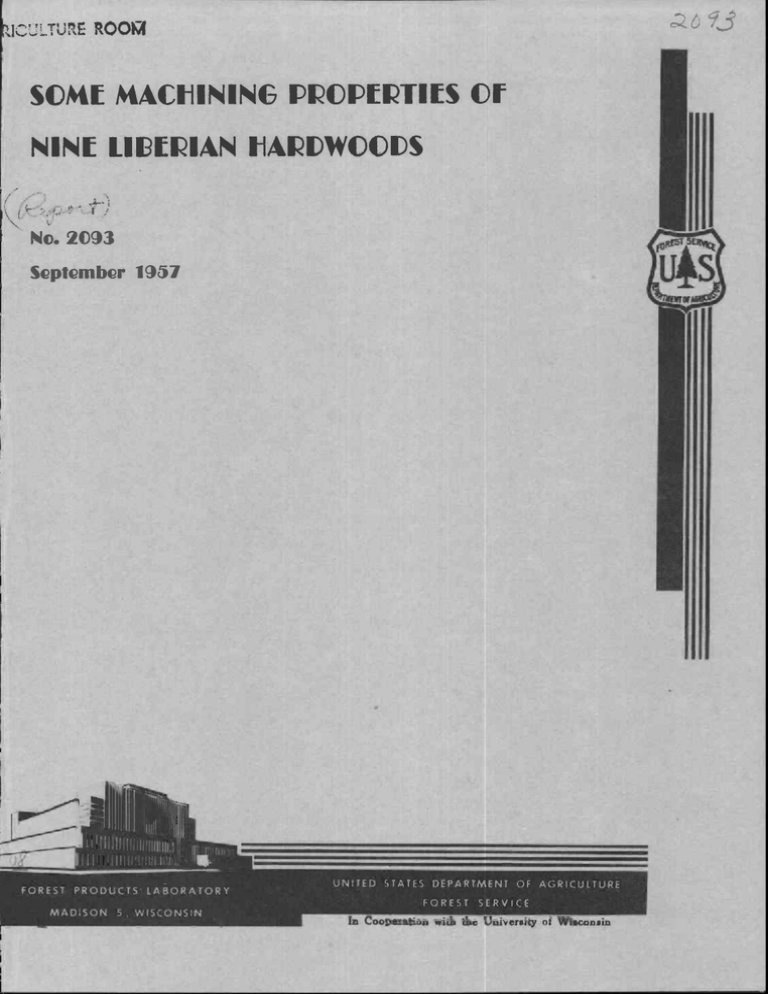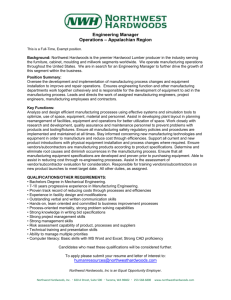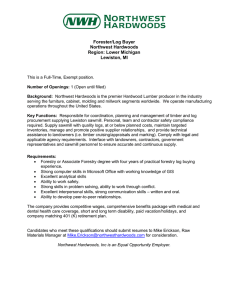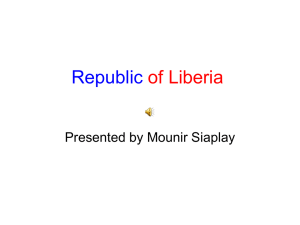rn SOME MACHINING PROPERTIES OF NINE ILIIARIAN HARDWOODS aZO
advertisement

aZO 0:2L:TUR5 ROOM SOME MACHINING PROPERTIES OF NINE ILIIARIAN HARDWOODS rn FOREST PRODUCTS' LABORATORY UNITED STATES DEPARTMENT OF AGRICULTURE FOREST SERVICE MADISON 5 , WISCONSIN In Coo on with the University of Wisconsin 1 SOME MACHINING PROPERTIES OF NINE LIBERIAN HARDWOODS — By E. M. DAVIS, Technologist 2 Forest Service Forest Products Laboratory, — U. S. Department of Agriculture Summary Good machining properties are highly important for cabinet work or similar uses. Different Liberian species vary in these properties, as do native American hardwoods. The best Liberian woods tested were about on a par with the best native hardwoods in machining properties, and the rest would be considered adequate by United States standards. Introduction As a result of long-continued skimming of their cream, the hardwood forests of the United States now yield a very small percentage of high-grade lumber, especially in the larger sizes. This situation has aroused increasing interest in tropical hardwoods as possible high-quality substitutes. In addition to such familiar exotics as mahogany and teak, new species have been entering our markets in increasing volume. Asia, Africa, and South America have all contributed, and the trend appears likely to continue. For this reason, the more important machining properties of certain Liberian hardwoods were investigated as one criterion of their suitability for high-quality woodwork. 1 — This work was done in cooperation with the International Cooperation Administration. 2 —Maintained at Madison, Wis. , in cooperation with the University of Wisconsin. Rept. No. 2093 -1- Agriculture-Madison The Test Material Table 1 gives some pertinent information on the species that were tested. Their color varied from blond through light yellow and light reddish brown, to dark reddish brown. The range in specific gravity was wider than in common native American hardwoods. The woods numbered 1, 3, 4, and 5, in table 1 are substantially heavier than hickory. As compared with oak, for instance, more power is required to machine them, they dull tools more quickly, and generally reduce production somewhat. Some resistance to their sales in this country may therefore be expected, except for uses where high density is a definite asset. Species 2, 6, and 7 are about equal to oak and beech in density, while No. 8 is slightly lighter. Other things being equal, these four would appear to hold more promise for use here than the extremely dense woods. The only lightweight wood in the lot, No. 9, is about on a par with American basswood. The only fine-textured wood is No. 4. All the others have pores about like those in black walnut -- coarse enough to require a filler to produce a fine finish. Most of these woods showed some degree of ribbon-stripe figure when quartered. Because of the small number of samples that were tested, the findings of this report should be considered only as indicative. Testing Procedure Planing Table 2 compares the planing properties of the nine Liberian woods under the indicated working conditions. Three native American hardwoods are included for comparison. In general, the Liberian woods made very good showings. Ninety percent of the planed species were defect free in tests of Tarrietia, the best Liberian wood, while for oak 87 percent of the pieces were defect free. In the poorest Liberian wood, Entandophragma, only 17 percent of the pieces were defect free as compared with 21 percent for native cottonwood. The most common planing defect was chipped grain, which was largely limited to the quartered material and found to some extent in all species. Raised Rept. No. 2093 -2- grain was the only other defect that was at all common. From its nature, raised grain would be more easily remedied by sanding than the chipped grain. The typical appearance of these defects is shown by figure 1. The quality of finish obtained with planer-type machines may vary widely, depending upon operating conditions. One of the most important factors is the number of knife cuts per inch. A series of four runs was made with test material at 6 percent moisture content. An 8-inch molder was used with a 20-degree knife angle, the machine was run at 3,600 revolutions per minute, and feed rates were adjusted to give 8, 12, 16, and 20 knife-marks per inch in the different runs. The results showed 16 cuts per inch to be about the minimum number for best results. There was little apparent advantage in going higher, and the quality fell off rapidly below that point. The cutting angle, or angle between the cutting edge and a radial line in the cutterhead, is another important factor. Four runs were made with cutting angles of 10, 20, 30, and 40 degrees, with test material at 6 percent moisture content, the machine running at 3,600 revolutions per minute, and a feed rate of 60 feet per minute. For the Liberian group as a whole, the 20degree cutting angle proved to be best. This agrees with Laboratory experience with native American hardwoods. The available amount of test material did not permit investigating the factors of moisture content and depth of cut. Native American and Philippine hardwoods plane better at 6 percent moisture content than at 12 percent, and much better than at 20 percent. In planing native and Philippine hardwoods with four different depths of cut -- 4/32, 3/32, 2/32, and 1/32 inch -- it was found that results steadily improved in going from the heaviest to the lightest cut. It is probable that Liberian hardwoods would follow the same general trends. The typical grain and texture of three of the Liberian woods are shown in figures 2, 3, and 4. Shaping In the shaping test, Liberian hardwoods, like the American species, showed a wide spread between the best and the poorest (table 3). Several of the better woods shaped as well as mahogany. In general, the denser and finertextured woods gave the best results. The lightest wood, Terminalia, developed tearouts when the end grain was cut, as shown in figure 5. This behavior is fairly typical of light species in general. The most common defect by far was a surface roughness of a type that can be readily sanded off. This Rept. No. 2093 -3- roughness consists largely of portions of pore walls that did not sever cleanly, but were pushed into the pore openings and later recovered their original position. End-grain cuts were much worse in this respect than in others. Turning In turning, the species followed substantially the same order as in shaping, with the denser and finer-textured woods making the best showing. The imperfections found were of several types rather than any one main thing. The quality range from best to poorest was about the same as in native hardwoods, as shown in table 4. Figure 6 illustrates the test turnings in six of the Liberian species. A very slight increase in surface roughness can be noted in going from No. 1 to No. 6. The test turnings were made on a modified back-knife lathe, at 2, 200 revolutions per minute, and with the wood at 6 percent moisture content. Rept. No. 2093 -4- 1. -15 Table 1.--Description of nine Liberian woods tested for machining properties Botanical name 1. Anopyxis klaineana Common name : Bodioa Typical color :Specific: No. of :gravityl:samples : Light yellow : 0.88 : 5 2. Entandophragma ango- : Brown African lense mahogany : Walnut brown .63 : 10 3. Gilbertiodendron sp. : : Med. reddish brown : 76 : 4 4. Gluema ivorensis : Dark reddish brown : .99 : 6 85 : 5 5. Haplormosia mono- phylla : Liberian black gum : Dark yellowish brown • • 6. Monopetalanthus sp. 2– : Liberian pine : Light to medium : reddish brown 7. Sarcocephalus diderrichii : Bilinga : Light yellow 66 : 8. Tarrietia utilis : Wismore : Medium reddish brown 59 : 10 9. Terminalia ivorensis : Emeri : Blond .65 : 10 .42 : Total Average 6 6 62 71 : 1 –Based on weight when ovendry and volume when green. -Being reclassified as Tetraberlinia sp. by Centre Technique Forestier Tropical (France) on basis of additional herbarium material. Rept. No. 2093 7 Table 2.--Planing properties of Liberian hardwoods) compared with those of three North American hardwoods Name of wood : Defect-free pieces Percent Tarrietia utilis 90 White oak (North American) 87 Terminalia ivorensis 83 Gluema ivorensis • 83 Sarcocephalus diderrichii • 83 Gilbertiodendron sp. • 75 Yellow-poplar (North American) • 70 Monopetalanthus sp. 2 70 Haplormosia monophylla • 67 Anopyxis klaineana • 40 Cottonwood (North American) • 21 Entandophragma angolense 17 1 –Planed in cabinet planer at 3,600 revolutions per minute, 30degree cutting angle, 16-inch cut, and 6 percent moisture content. ?Being reclassified as Tetraberlinia sp. by Centre Technique Forestier Tropical (France) on basis of additional herbarium material. Rept. No. 2093 1 Table 3.--Shaping properties of nine Liberian hardwooda - compared with those of two American hardwoods Name of wood Good to excellent samples Percent Gluema ivorensis. 83 Haplormosia monophylla 83 Anopyxis klaineana 8o Entandophragma angolense 8o Mahogany (Central American) 78 Gilbertiodendron sp. 75 Monopetalanthus g 70 Tarrietia utilis 70 Sarcocephalus diderrichii 6o • Walnut (North American) . • 44 • Terminalia ivorensis 36 1 -Work done with spindle shaper at 7,200 revolutions per minute. 2 --Being reclassified as Tetraberlinia sp . by Centre Technique Forestier Tropical (France) on basis of additional herbarium material. Rept. No. 2093 Table 4.--Turning properties of nine Liberian hardwoods compared with those of two North American hardwoods Name of wood : Good to excellent turnings Percent Gluema ivorensis 100 Haplormosia monophylla 100 Anopyxis klaineana 100 Walnut (North American) Monopetalanthus 1 96 .. : 90 Entandophragma angolense 90 Tarrietia utilis 90 Sarcocephalus diderrichii • 75 Gilbertiodendron sp. • 75 Terminalia ivorensis • 67 Elm (North American) 60 1 –Being reclassified as Tetraberlinia sp. by Centre Technique Forestier Tropical (France) on basis of additional herbarium material. Rept. No. 2093 • • • INCHES. 1 lj liffillifill 1111111111111111111111 I Figure 1. --Chipped grain in Entandophragma angolense (above) and raised grain in Anopyxis Klaineana. Z M 111 896 11j 11111ilf L NOYES 1 1 1111111 11111111111111 11 11 I Figure 2. --Flat grain (above) and quartered grain in Monopetalanthus sp. (Liberian pine). Z M 111 894 1 111111110 1111111 1111111111111 Figure 3. --Flat grain (above) and quartered grain in Entandophragma angolense (brown African mahogany). Z M 111 895 1 I. 111 111 Iff liffiff III 111GI NCHES Figure 4. --Flat grain (above)) and quartered grain of Terminalia ivorensis (emeri). Z M 111 893 luestotrgvuimg.rwom assowevavo. ' -nSueSPM4-iiift*. Figure 6. --Turning test with six Liberian hardwoods: 1. Gluema ivorensis; 2. Haplormosia monophylla; 3. Tarrietia utilis; 4. Entandophragma angolense; 5. Anopyxis klaineana; and 6. Terminalia ivorensis. Z M 111 461


